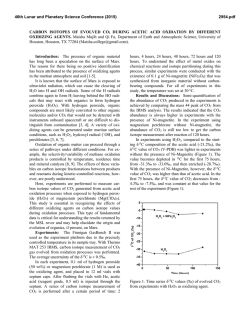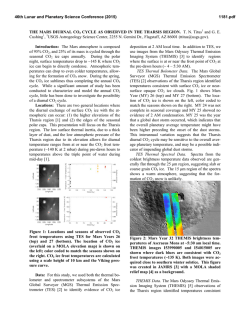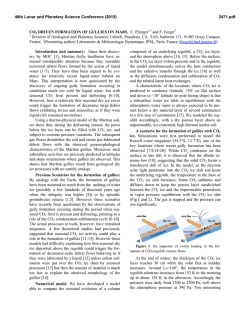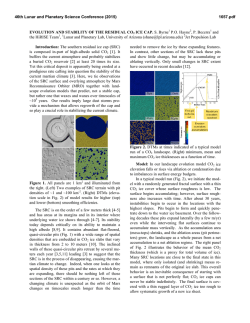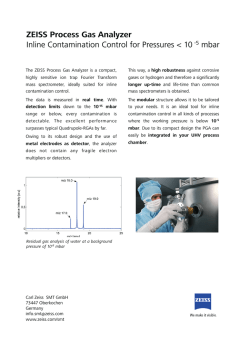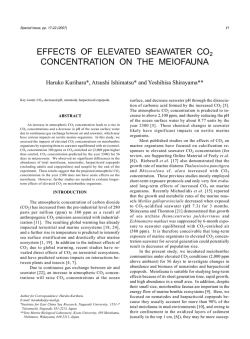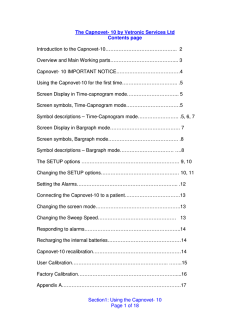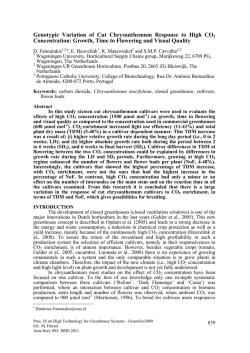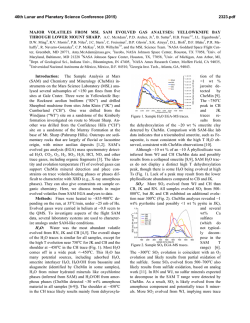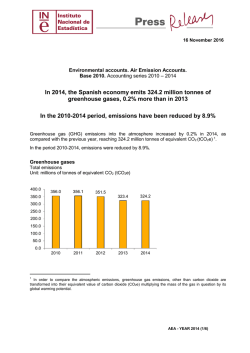
Investigating CO - USRA
46th Lunar and Planetary Science Conference (2015) 2840.pdf INVESTIGATING CO2 RESERVOIRS AT GALE CRATER AND EVIDENCE FOR A DENSE EARLY ATMOSPHERE. P. B. Niles 1, P. D. Archer2, E. Heil3, J. Eigenbrode 4, A. McAdam4, B. Sutter2, H. Franz4, R. Navarro-Gonzalez5, D. Ming 1, P. Mahaffy 4, F. J. Martin-Torres 5,7, and M. Zorzano 6; 1Astromaterials Research and Exploration Science, NASA Johnson Space Center, Houston, TX 77058; ([email protected]); 2Jacobs, NASA Johnson Space Center, Houston, TX 77058 3HX5-Jacobs JETS Contract, NASA Johnson Space Center, Houston, TX 77058, 4NASA Goddard Space Flight Center, Greenbelt, MD, 5Instituto Andaluz de Cienccias de la Tierra (CSIC-UGR), Grenada, Spain, 6Centro de Astrobiologia (INTA-CSIC), Madrid, Spain, 7Division of Space Technology Department of Computer Science, Electrical and Space Engineering, Lulea University of Technlogy, Kiruna, Sweden. Introduction: One of the most compelling features of the Gale landing site is its age. Based on crater counts, the formation of Gale crater is dated to be near the beginning of the Hesperian near the pivotal Hesperian/Noachian transition [1, 2]. This is a time period on Mars that is linked to increased fluvial activity through valley network formation and also marks a transition from higher erosion rates/clay mineral formation to lower erosion rates with mineralogies dominated by sulfate minerals [3]. Results from the Curiosity mission have shown extensive evidence for fluvial activity within the crater suggesting that sediments on the floor of the crater and even sediments making up Mt. Sharp itself were the result of longstanding activity of liquid water [4]. Warm/wet conditions on early Mars are likely due to a thicker atmosphere and increased abundance of greenhouse gases including the main component of the atmosphere, CO2 [5]. Carbon dioxide is minor component of the Earth’s atmosphere yet plays a major role in surface water chemistry, weathering, and formation of secondary minerals. An ancient martian atmosphere was likely dominated by CO2 and any waters in equilibrium with this atmosphere would have different chemical characteristics . Studies have noted that high partial pressures of CO2 would result in increased carbonic acid formation and lowering of the pH so that carbonate minerals are not stable [6]. However, if there were a dense CO2 atmosphere present at the Hesperian/Noachian transition, it would have to be stored in a carbon reservoir on the surface or lost to space. The Mt. Sharp sediments are potentially one of the best places on Mars to investigate these CO2 reservoirs as they are proposed to have formed in the early Hesperian, from an alkaline lake, and record the transition to an aeolian dominated regime near the top of the sequence [1]. This study seeks to better understand the CO2 content of the soils and sediments investigated by the MSL rover at Gale crater with the goal of trying to piece together the nature of the atmosphere and climate during the early Hesperian. Methods: The SAM instrument on the MSL rover provides the capability of analyzing drilled sample powders via pyroloysis and evolved gas analysis (EGA) via mass spectrometry [7]. This capability provides an excellent insight into the nature of CO2 in the samples as the temperature at which CO2 evolves is highly indicative of the nature of the phase in which it is stored. In general carbonate minerals evolve between 500 and 800 C while reduced carbon phases evolve at temperatures lower than 400 C. In both cases there can be exceptions to this relationship, so it is important to interpret EGA results with care. Results: The SAM instrument has examined 5 different samples from the Gale crater region and CO2 has been a major volatile component of each sample, however the carbon contents have not indicated that a carbon containing phase such as carbonate minerals make up a significant portion of the samples. All samples have CO2 contents below 1 wt% but not below 0.1 wt% (Table 1). The Rocknest soils are the only samples which show a substantial CO2 evolution above 500° C, indicating the possible presence of carbonate minerals. All of the other samples analyzed to date have shown lower temperature CO2 releases indicating that the CO2 is not evolving from a carbonate mineral (see discussion below). Discussion: The presence of significant CO2 (> 0.1 wt%) within all of the samples analyzed to date suggests that these samples do show some interaction with the atmosphere. However, the amount of CO2 present and the temperatures at which it evolve are substantially different from what was expected. 46th Lunar and Planetary Science Conference (2015) Table 1. Average CO2 evolved from samples analyzed by the SAM instrument. C Evolved CO2 (ppm) (µmol)* Rocknest 9.9 ± 1.9 2640 John Klein 6.9 ± 1.8 1840 Cumberland 2.7 ± 1.0 720 Windjana 9.2 ± 2.3 2453 Confidence Hills 4.3 ± 1.5 1147 Sample Wt% CO2 GEL 10m GEL 50 m 1.0% 0.7% 0.3% 0.9% 0.4% 11 mbar 8 mbar 3 mbar 10 mbar 4 mbar 54 mbar 38 mbar 16 mbar 48 mbar 21 mbar 1.6x10 -9 O2 CO2 1.4 Ion Current 1.2 CO2 1.0 O2 0.8 0.6 0.4 0.2 0.0 200 250 300 350 400 Temperature/ºC 450 500 Figure 1. Evolution of CO2 and O2 during laboratory analysis of Fe(II) Oxalate + Mg Perchlorate using JSC SAM Testbed [13]. 5x10 CO2 O2 (6x) 6 CO2 CO2 O2 O2 4 Counts/s The total amount of CO2 in these sediments does not indicate the presence of a substantial reservoir of CO2 (Table 1). Assuming that these samples may have similar carbon content to the average martian soil, then a 50 m global equivalent layer (GEL) yields only 50 mbar of CO2 storage. This is well short of the ~1 bar estimates of the ancient martian atmosphere [5]. The CO2 releases in all of the samples analyzed to date are also well below 500° C. While it might be possible that this is from a fine grained carbonate mineral [8], this has not yet been demonstrated and most carbonates decompose above 500° C, even Fe/Mg rich varieties. CO2 releases are often associated with oxygen releases in the martian data (Fig. 2) suggesting possible combustion of organic matter [9]. However, if this is true it suggests substantial quantities of organic carbon (up to 2000 ppm) (Table 1), and GCMS analyses do not detect substantial organic fragments that might be associated with kerogen or other complex organic carbon species [10]. Instead it is evolved entirely as CO2 and CO. This suggests some other form of oxidized carbon may be the carbon source. One intriguing possibility is Fe(II) oxalate (Fig 12) which releases CO2 at a very similar temperature [10, 11]. Oxalate minerals could form as a result of the breakdown of more complex organic species [11], or could possibly be the result of radiolysis of CO2 hydrates [12]. Conclusions: The total amount of CO2 in the Gale crater soils and sediments is significant but lower than expected if a thick atmosphere was present at the Hesperian/Noachian boundary. Likewise, the absence of carbonates suggests that CO2weathering processes similar to those present on Earth were not dominant. Instead it is possible that more exotic CO2 deposition has occurred driven by atmospheric photochemistry and/or degradation of organic carbon. 2840.pdf 3 2 1 200 250 300 350 400 Temperature (°C) 450 500 Figure 2. Evolution of CO2 and O2 during MSL-SAM analysis of mudstone from John Klein site on Mars . References: 1. Milliken R.E., et al. (2010) Geophysical Research Letters, 37, 04201. 2. T homson B.J., et al. (2011) Icarus, 214, 413-432. 3. Bibring J.P., et al. (2006) Science, 312, 400-404. 4. Grotzinger J.P., et al. (2014) Science, 343. 5. Pollack J.B., et al. (1987) Icarus, 71, 203-224. 6. Fairen A.G., et al. (2004) Nature, 431, 423-426. 7. Mahaffy P., et al. (2012) Space Science Reviews, 170, 401-478. 8. Archer P.D., et al. (2014) LPI Contributions, 1791, 1075. 9. Ming D.W., et al. (2014) Science, 343. 10. Eigenbrode J.L., et al. (2014) Lunar and Planetary Science Conference, 45, 1605. 11. Benner S.A., et al. (2000) Proceedings of the National Academy of Sciences of the United States of America , 97, 2425-2430. 12. Oshima M., et al. (2012) Lunar and Planetary Science Conference, 43, 1976. 13. Leshin L.A., et al. (2013) Science, 341.
© Copyright 2025
